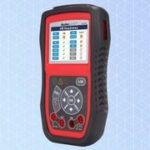The ANCEL AD410 PRO OBD2 Scanner emerges as an indispensable tool for vehicle owners and automotive enthusiasts alike. This 2-in-1 device combines robust OBD2 engine diagnostics with advanced battery testing capabilities. With its user-friendly design and comprehensive features, the Automatic Pro Obd2 scanner, ANCEL AD410 PRO, empowers you to understand your car’s health like never before. From deciphering check engine lights to evaluating battery performance, this tool offers a seamless diagnostic experience.
Why Choose an Automatic Pro OBD2 Scanner Like the ANCEL AD410 PRO?
In today’s automotive landscape, understanding your vehicle’s condition is crucial for preventative maintenance and cost savings. The ANCEL AD410 PRO functions as your automatic pro obd2 scanner, providing effortless access to your car’s onboard diagnostic system. It supports all OBDII functions, allowing you to read and clear fault codes, monitor emissions readiness, and access live data streams. This means you can quickly identify the cause of that persistent check engine light or ensure your vehicle is ready for emissions testing, all from the convenience of your garage.
Beyond basic engine diagnostics, the ANCEL AD410 PRO steps up as a professional-grade battery tester. It goes beyond simply checking voltage, offering in-depth analysis of battery health, cranking performance, and charging system status. The scanner presents this critical battery information in intuitive graphs, enabling you to proactively manage your battery’s lifespan and avoid unexpected breakdowns. This dual functionality sets the AD410 PRO apart as a truly versatile automatic pro obd2 scanner.
Key Features that Define the Automatic Pro OBD2 Scanner ANCEL AD410 PRO
The ANCEL AD410 PRO is packed with features designed for both novice and experienced users:
- Full OBDII Functionality: From reading and erasing codes to advanced functions like O2 sensor tests and on-board monitor testing, this scanner covers all your essential diagnostic needs. It accurately interprets diagnostic trouble codes (DTCs), helping you pinpoint issues efficiently.
- Professional Battery Testing Suite: Evaluate battery health, cranking voltage, and charging system performance. Compatible with a wide array of battery types including Regular Flooded, AGM Flat Plate, AGM Spiral, GEL, and EFB, and supports multiple testing standards like CCA, BCI, CA, MCA, JIS, DIN, IEC, EN, SAE, and GB.
- Extensive Vehicle Compatibility: This automatic pro obd2 scanner is compatible with most OBD2 compliant vehicles from 1996 onwards (check specific compatibility for European and Asian makes post-2003/2005 respectively, and specific car brands listed).
- User-Friendly Interface: Features a 2.8-inch TFT color screen for clear data display and a 2.5-foot cable for comfortable access to the OBD2 port. The multilingual support caters to a global user base.
- Diagnostic Reporting and Lifetime Updates: Save diagnostic reports for record-keeping or sharing with mechanics. Benefit from lifetime free software updates, ensuring your tool remains current with the latest vehicle models and diagnostic parameters.
Maximize Your Car Care with an Automatic Pro OBD2 Scanner
The ANCEL AD410 PRO automatic pro obd2 scanner is more than just a code reader; it’s a comprehensive vehicle health tool. It empowers you to:
- Diagnose Check Engine Lights: Understand and address the root cause of engine issues, potentially saving on costly mechanic visits for simple fixes.
- Maintain Battery Health: Proactively monitor your car battery’s condition, preventing unexpected failures and ensuring reliable starts.
- Ensure Emissions Readiness: Verify your vehicle’s emission systems are functioning correctly, helping you pass inspections and contribute to environmental responsibility.
- Gain Vehicle Insights: Access real-time data and vehicle information to better understand your car’s operation and performance.
In conclusion, the ANCEL AD410 PRO automatic pro obd2 scanner is a valuable investment for anyone looking to take control of their vehicle maintenance. Its combination of OBD2 diagnostics and battery testing, coupled with ease of use and broad compatibility, makes it an essential tool for modern car care. Whether you’re a seasoned mechanic or a first-time car owner, the AD410 PRO provides the professional-level diagnostics you need in an automatic and accessible package.
